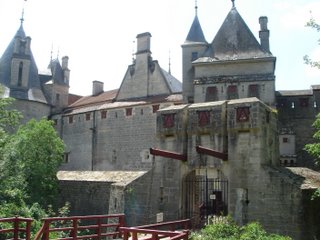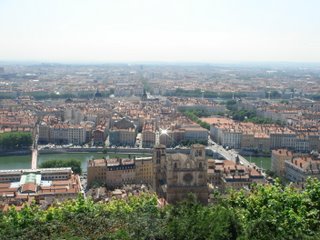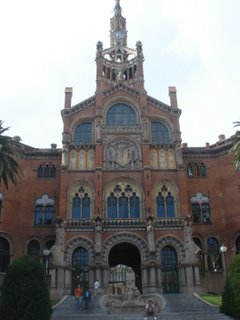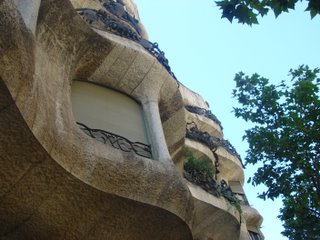Montpellier-Nîmes-Orange.
Trip dist: 119 kms. Trip time: 6 hrs, 34 mins. Tot dist: 2779 kms.
Corollaries.
Oh, man. Today was one of my luckiest days. I knew something was going to be amiss when I walked into a McDonald's at Nîmes (half-way stop. I was in a hurry. Dying of thirst and sodas cost through the roof here but not at the American Empire--so much). These days, McDonald's is promoting itself through some World-Cup related game in which you scratch three columns of a 3x3 matrix on a game card. The matrix can have either two or three "win" boxes--symbolized by the picture of a soccer ball, while the other 6 or 7 boxes in the matrix are "lose" and marked as "x"s (for official rules take a look
here, for instance). So basically you scratch only one box per column and if you happen to find either two or three soccer balls, you win something. If you find only two, you win things like a Big Mac, or a soda, or some fries, etc. But if you find three soccer balls, you can get big prizes like an X-box, or a scooter, or even a Hyundai!
Well, imagine my surprise when in idly scratching the gamepiece because I was bored, I chanced to scratch precisely the three hidden soccer balls.
Now, assuming the probability of finding a soccer ball in each column is 1 in 3 (and I'll tell you why it is not in a minute, but hold on...), then, assuming also that all game cards have 3 "you win" soccer balls hidden in them, the chances of you finding the three balls are 1 in 27. Pretty low, in general. But you must also consider that this number is too high for any casino, let alone a McDonald's, with thousands of sites in every major city around the world, if you're giving prizes as large as the ones just mentioned, and at an average of two game pieces per person (a big-sized menu with a Big Mac will contain one game piece for the large soda and another for the Big Mac), these are not worthwhile odds, from the McDonald's perspective.
So, McDonald's, smartly, does three things. 1) Not all the game pieces contain 3 "win" soccer balls. In fact, most of them contain only 2. (I have yet to find out if there are any game pieces that contain less than 2, but I don't eat at McDonald's that often, and asking friends to keep track for me when they eat there may immediately label me as a little on the strange side, so I keep my ponderings on the matter rather quiet--or at least as quiet as a public forum like this one allows), 2) Even on the game pieces that contain 3 soccer balls, the prizes are usually rather cheap (i.e., tote bags, soccer balls, things of that sort), and 3)they tell you on the rules that if you scratch more than the 3 required boxes, or if you scratch more than the designated prize box (you have to scratch one of two possible prize boxes according to whether you found 2 wins, or 3), the game piece is null and void (so as to keep the gamer's hopes up that they might have won 3, even when in fact they couldn't, and keep them trying/buying, I guess, since everyone always assumes they have a fighting chance to win at big casinos, right?). The reason I know these things is because, of course, being an engineer, and loving probability problems, I always scratch all of the boxes, regardless of whether I've won or not (but most often because I have not won, as expected).
The point is, that even assuming the following best case scenario: 1. That the game card always contains at least 2 "win" boxes, and 2. That half of the game pieces printed contain 3 "win" boxes (a rather generous assumption), then that brings the probabilities of
my having found 3 win boxes to 1 in 54. Very, very low. So, I was being very, very lucky (the prize, being a tote bag, was worthless for me, so I of course subsequently scratched all the other boxes--including the other prize box, which turned out to be an espresso--equally worthless for me since I seldom drink coffee and then I would never drink one at a fast-food place--I'm a bit particular about espressos, as you may know...thus rendering the game piece null and void according to McDonald's rules).
Now, according to the
Pasquali Law of Conservation of Luck, winning somthing with probability 1/54 (best case--actual probability most likely quite a bit less, depending on actual/real proportion of "3 win" cards printed...) is an event of notice because of two reasons: 1)it is a big spike in the positive "luck axis" which in a closed system will soon be offset by an either equally or most likely larger spike in the opposite (negative) direction to offset the latest good luck spike plus all other "good lucks" accumulated within the measurement period, and 2) better do something exciting real soon before the "good luck spike" effect wears off. So you can imagine with what mixture of nervousness and anticipation this event was received!
Now, due to the numerous various and mathematically subtle probabilistic corolaries of such law, however (the link I gave you only lists 2 of them, unfortunately. Ask me later for the full list and illustrative lecture), it is often difficult to determine with much certainty when the "closed system time measurement period" begins and ends. Most often, in fact, it is a lot easier to tell in retrospect, once the "bad" and "good" luck spikes have already balanced themselves, such that if you plot the luck on a graph vs time, and use a slididing window of variable length along the x-axis, eventually, with some practice, you can figure out where the measurement period corresponding to, say, the time between t0 and t1 are, where t0 and t1 are, correspondingly, the start and the end time of the closed system time (and which also correspond to the length of the sliding window).
Confusing? Yeah, I told you the proof involves a lot of Bessel functions and multidimensional tensors and junk like that. {shrug} But anyway...
So, thus nervous and excited (Probabilistic Corollary #2 implied that my next stroke of "luck" was going to be big and in the negative direction, while the longer the time passed between the time I scratched the game card and the negative spike, the worse the spike was going to be, according to Probabilistic Corollary #1...), I continued a rather uneventful ride along the roads of the hot French summers.
Until I stopped at a gas station 25 kms from Orange to buy some water, and discovered that my money bag (since I lost my wallet I kept my money and brand new replacement ATM bank card in a little plastic bag) had fallen out of my shorts pocket.
Uh oh. No, no, not again! First things first: yes, it had fallen out, I had not left it somewhere, for only 10 kms ago I had taken it out to pay for some fruit juice at a juice stand by the road, and I was absolutely positive I had replaced it in the pocket, I had double-checked. Second: yes, my bank card was in it, and the nightmares from suffering through 45 minutes of inept customer service from Citibank employees and 4 days of stress without being able to withdraw money were still quite fresh in my mind.
25 kms to go. I had the money bag/makeshift wallet 10 kms ago. Bank card precious, replacing it very difficult. What to do?
Elisa biked back, hoping the Probabilistic Corollaries had not quite kicked in yet, that this was just an aberration, that my law had its flaws, just like the Ptolemaic planetary system, and all the nonsense I just told you about with the Bessel functions was just that, and oh how could I be so stupid again in such a short time span? (being stupid over a longer time span is more easily forgiven, so long as the stupidity is not continuous...).
Well, guess what! Fortunately, the "good spike" effect had not yet worn off, for I found my little plastic bag, 4 kms behind, sitting peacefully by the side of the road, caught in-between the stands supporting a car protective barrier, and thus prevented from falling into some rather inaccessible territory!!! Ha ha ha ha!! Lucky, lucky day! (or great eyesight. But since you know I wear glasses you know this is not the correct explanation). With the bank card intact, as well. Lesson learned: last laundry run where I actually dried my shorts in the dryer instead of air-drying like I usually do shrank my shorts a bit. Mental note to self: pockets unreliable now for anything more than spare change in coins.
Whew! You have to imagine, I was so relieved. And, what's more, the good luck continued throughout the day, for after arriving in Orange, when I stopped for dinner at a restaurant, the waiter who had been chit-chatting with me a bit throughout my meal despite my horrible French, left me his phone number written on the check. When I looked up to him with raised eyebrow at this, he grinned and simply said, "Oh, when you asked me from the check and made some writing sign I thought you were asking me for my number, so here it is." Smooth, eh? :) I couldn't help chuckling to myself a bit as I got up and received, from a distance (for he had already gone to attend to another table), some rather animated gestures of a phone by one's ear and the mouthing of the words "Call me!".
{sigh} If only things in the U.S. had been so easy....








